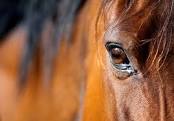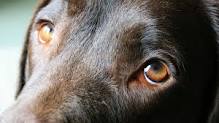
We are all familiar with the expression “Oculi speculum animae”, the eyes are the mirror of the soul. When we look at another person’s eyes, we can tell a great deal about how that person is feeling at that moment: calm, afraid, angry, sad, depressed, disbelieving… and this information helps us modulate our approach.
When we are working with dogs, most people are aware that observing the dog’s eyes is key to gauging the animal’s state of mind at that mo ment. Is the gaze soft and gentle or hard and staring? Are the whites of the eyes visible (whale eye)? Is the expression fearful? Do the eyes communicate trust in the person? Depending on what we see in the dog’s eyes, we can adjust our own approach and behaviour. We can take things more slowly in training if we see that the dog is not confident or is fearful. We can take advantage of the dog’s enthusiasm to teach new, exciting things. The eyes are like our barometer.
ment. Is the gaze soft and gentle or hard and staring? Are the whites of the eyes visible (whale eye)? Is the expression fearful? Do the eyes communicate trust in the person? Depending on what we see in the dog’s eyes, we can adjust our own approach and behaviour. We can take things more slowly in training if we see that the dog is not confident or is fearful. We can take advantage of the dog’s enthusiasm to teach new, exciting things. The eyes are like our barometer.
Of course, it is not a one way street. Our gaze will also tell the dog a lot about us and what our intentions are. If we look an unfamiliar dog straight in the eyes, this is a potentially confrontational stance. We could be infringing that dog’s personal space which would make us not very trustworthy in his eyes. When it is our own dog who knows us, is used to direct visual contact with us and understands our visual communication, that is a different matter. If we avert our gaze we can communicate that we are not a threat and respect the dog’s space. It may take us longer to reach our goal, but we will be treading on secure ground and establishing a relationship of trust and respect which will pay off in the long run.
With cats visual contact can be even more delicate. Direct hard stares will almost definitely be interpreted as confrontational and will do nothing to foster a bond between us and the cat. One of the most powerful eye strategies with cats is the slow blink. Cats use it all the time and they can recognise it when we do the same. This is a fundamental tool in our cat relationship.
This has been brought home very forcefully to me over the past 18 months. Some of you may know that a feral cat had four kittens in the loft of my garage. So successfully did she hide them that we could not find out where she was keeping them. When they were 6 weeks old, she brought them down to the garage and presented them to us, but by then they had learned the lessons she had taught them very well. At a signal from her, the kittens disappeared behind shelves or any other nearby hiding place, and getting close to them was almost impossible. Touching them certainly was, despite the fact that I would sit down close by when I fed them. All this was compounded by the fact that I had fractured my shoulder and was unable to move my left arm! Catching them to have them neutered was a nightmare, but that is another story…
Over time they have become more trusting. They know that we will do them no harm. They know that they will be fed. They know that they can sleep undisturbed. The eyes have been a major player in building this relationship of trust. At first, I averted my gaze when I had to pass close by. Gradually I was able to make more direct visual contact without frightening them. They also began to make more direct visual contact, particularly when they asked for food.
The most timid one could not be looked at at all. She was also incapable to looking at us and would hide under a car or a table. Only in the last couple of months has she begun to look directly and she can also accept me looking at her. We engage in slow blink sessions and I am convinced that this has been key to the progress we have made.
The eye lessons have not been limited to cats and dogs, however. At the end of February, the swallows who have been rearing chicks in our garage each year arrived after their long migration. Being totally tuned in to the power of the eyes, I realised more than ever before just how our gaze affected the swallows’ behaviour. If anyone looked at them directly, they would immediately fly away. Once they had laid their eggs in the nest, we had to keep our head bowed as we passed by. Otherwise, a great hue and cry arose and they would leave the nest and fly off.
It was not just our eyes that caused a strong reaction. Even greater was the reaction when the cats looked up at the birds and understandably so. Trying to reconcile cohabitation in the same space by a family of feral cats and swallows is not easy task! The cats would sit under the nest of the cord we have strung as a night-time perch and wait patiently. That strong stare was just too much for the swallows to bear! In the end we managed to referee the situation and ten chicks were fledged over the course of the summer.
If I was already aware of the importance of our gaze, these two experiences have brought home just how crucial it is to be aware of how and when we look at another living being. The eyes truly are the mirror of the soul!
